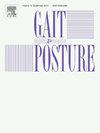Lower limb deformity and gait deviations of osteogenesis imperfecta
IF 2.2
3区 医学
Q3 NEUROSCIENCES
引用次数: 0
Abstract
Background
Osteogenesis imperfecta is a rare genetic disorder characterized by complex lower limb deformities, resulting in various gait limitations. This study aimed to (1) investigate the incidence and association between radiographic changes and gait impairment; (2) propose a lower limb deformity index to quantify deformity severity as well as gait performance.
Methods
Bilateral X-ray images and 3D gait analysis results were assessed retrospectively from 48 patients with osteogenesis imperfecta. Multivariate linear regression was used to investigate the contribution of each deformity to gait performance. Eight scoring approaches of the proposed index, calculated from radiographic changes, were evaluated by their linear relationship to gait deviation.
Results
Patients with osteogenesis imperfecta had high incidence of anterolateral bowing of femur, and anteromedial bowing of tibia, along with abducted hip, varus knee, hip flexion and ankle dorsiflexion deformities. Their maximum joint kinematics and kinetics were less than healthy controls, which was consistent with their major deformities. However, multivariate linear regression indicated a limited contribution from each deformity to gait deviation (only mechanical axis deviation out of 14 radiographic measures showed significance). Remarkably, our proposed index presented a significant linear correlation to gait deviation (Correlation coefficient: −0.650; R square: 0.423; F value: 33.719, p < 0.001).
Conclusions
This study preliminary demonstrated the association between lower limb deformities and gait deviations of patients with osteogenesis imperfecta and proposed a lower limb deformity index to quantify the deformity severity that reflects gait performance.
成骨不全的下肢畸形和步态偏差
背景:骨骼发育不全是一种罕见的遗传性疾病,其特征是复杂的下肢畸形,导致各种步态限制。本研究旨在(1)调查影像学改变与步态障碍的发生率和相关性;(2)提出下肢畸形指数,量化畸形严重程度和步态表现。方法回顾性分析48例成骨不全患者的双侧x线图像和三维步态分析结果。使用多元线性回归来研究每种畸形对步态表现的贡献。根据影像学变化计算的八种评分方法,根据其与步态偏差的线性关系进行评估。结果成骨不全患者股骨前外侧弯曲、胫骨前内侧弯曲发生率高,并发髋关节外展、膝内翻、髋关节屈曲和踝关节背屈畸形。他们的最大关节运动学和动力学小于健康对照组,这与他们的主要畸形一致。然而,多元线性回归显示,每种畸形对步态偏差的贡献有限(在14项x线测量中,只有机械轴偏差显示出显著性)。值得注意的是,我们提出的指数与步态偏差呈显著的线性相关(相关系数:−0.650;R方:0.423;F值:33.719,p <; 0.001)。本研究初步证明了成骨不全患者下肢畸形与步态偏差之间的相关性,并提出了一个下肢畸形指数来量化反映步态表现的畸形严重程度。
本文章由计算机程序翻译,如有差异,请以英文原文为准。
求助全文
约1分钟内获得全文
求助全文
来源期刊

Gait & posture
医学-神经科学
CiteScore
4.70
自引率
12.50%
发文量
616
审稿时长
6 months
期刊介绍:
Gait & Posture is a vehicle for the publication of up-to-date basic and clinical research on all aspects of locomotion and balance.
The topics covered include: Techniques for the measurement of gait and posture, and the standardization of results presentation; Studies of normal and pathological gait; Treatment of gait and postural abnormalities; Biomechanical and theoretical approaches to gait and posture; Mathematical models of joint and muscle mechanics; Neurological and musculoskeletal function in gait and posture; The evolution of upright posture and bipedal locomotion; Adaptations of carrying loads, walking on uneven surfaces, climbing stairs etc; spinal biomechanics only if they are directly related to gait and/or posture and are of general interest to our readers; The effect of aging and development on gait and posture; Psychological and cultural aspects of gait; Patient education.
 求助内容:
求助内容: 应助结果提醒方式:
应助结果提醒方式:


